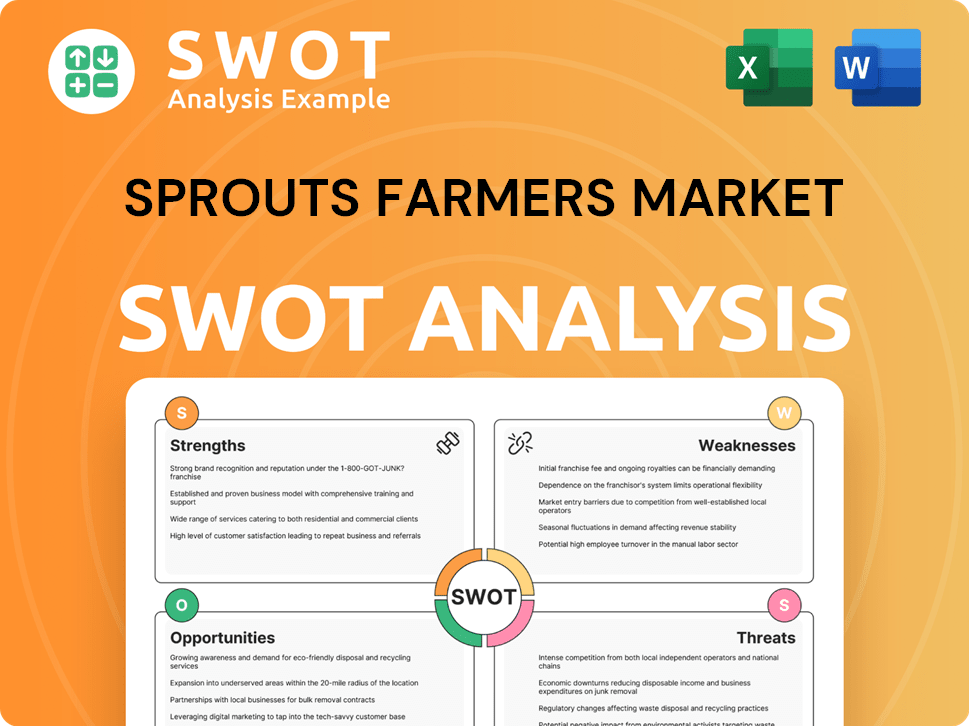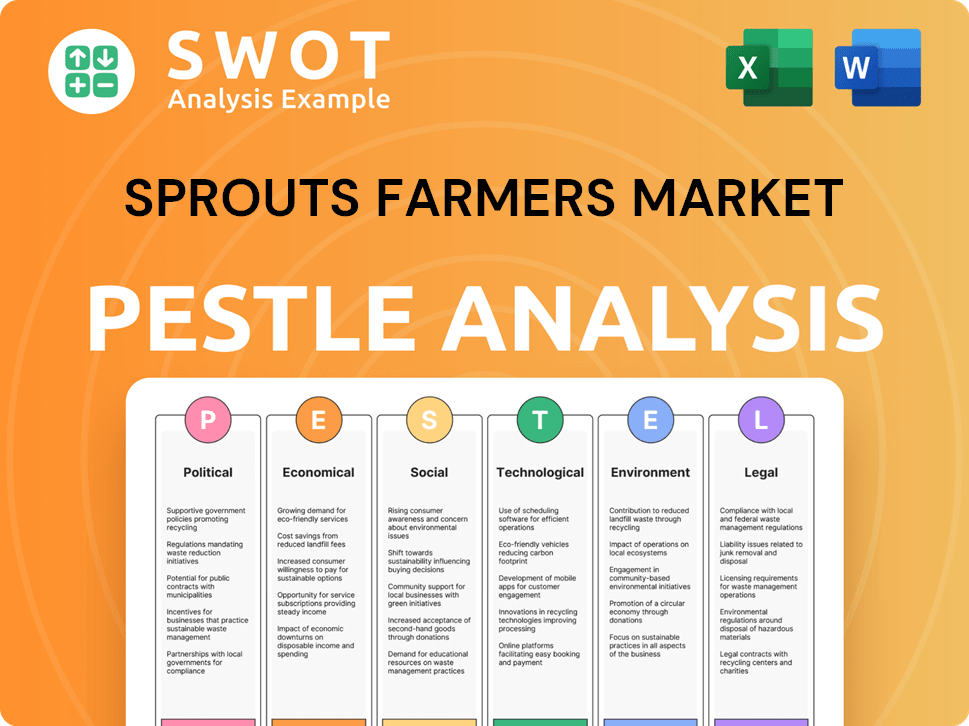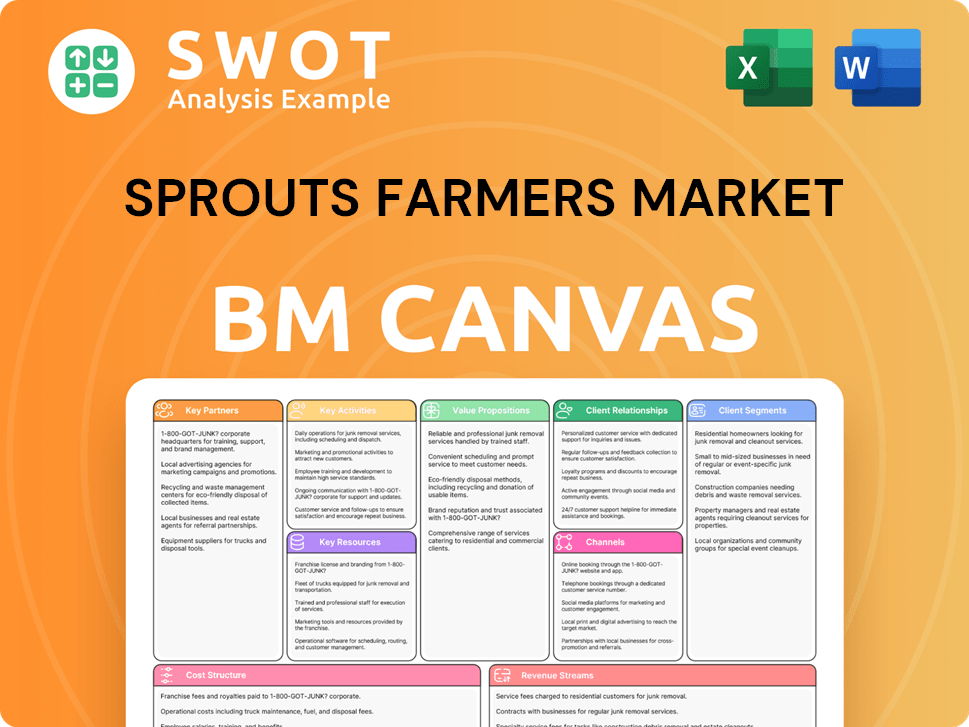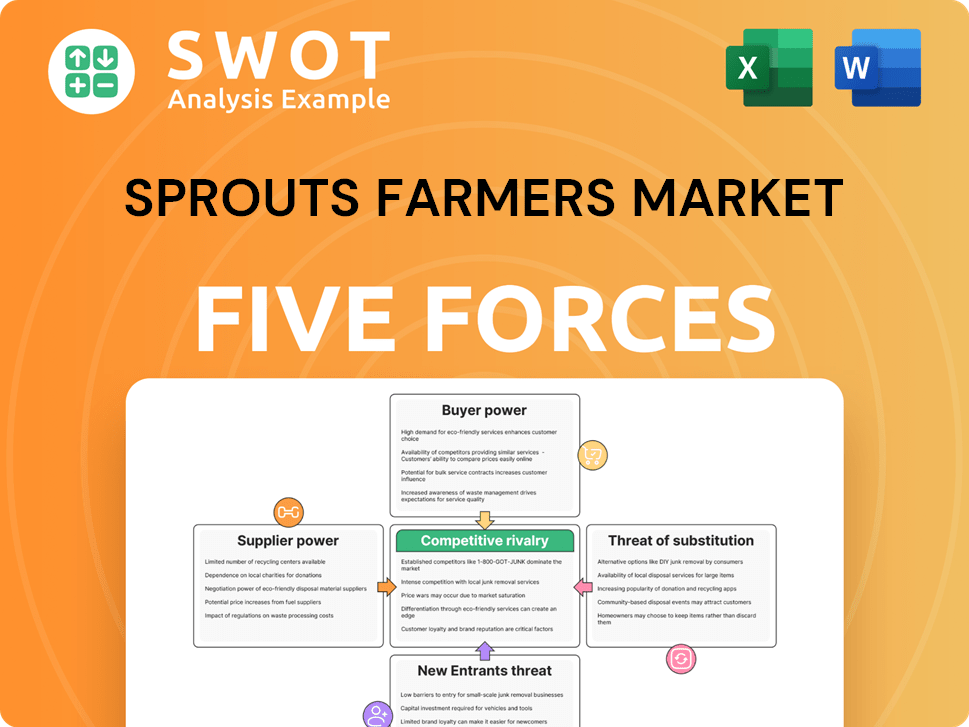Sprouts Farmers Market Bundle
Can Sprouts Farmers Market Continue to Thrive?
The grocery retail sector is a battleground, especially for natural and organic food providers. Sprouts Farmers Market, a key player since 2002, has built a strong brand around accessible health. Understanding its Sprouts Farmers Market SWOT Analysis is crucial to grasping its position in this dynamic market.

From its Arizona roots, Sprouts Farmers Market has expanded to over 400 stores, demonstrating significant retail expansion. This growth reflects a successful strategy in capturing market share within the organic food offerings sector. The company's future prospects depend on its ability to navigate market trends and capitalize on growth opportunities, making it a compelling subject for market analysis.
How Is Sprouts Farmers Market Expanding Its Reach?
The growth strategy of Sprouts Farmers Market is centered on expanding its physical presence and optimizing its store formats. The company is actively pursuing a disciplined approach to expand its footprint. This expansion is a key element of its strategy to capture a larger share of the growing natural and organic food market.
The company plans to open approximately 30 new stores in 2024. This expansion is primarily focused on its smaller, more efficient prototype, which averages around 23,000 square feet. This smaller format allows Sprouts to enter a broader range of markets and achieve stronger sales per square foot.
Beyond new store openings, the company is focused on enhancing its existing store base through remodels and optimizing its product assortment to cater to local preferences. The goal is to increase market penetration, reach new customer segments, and enhance the overall shopping experience. The emphasis on smaller store formats is driven by a desire for improved profitability and efficiency.
Sprouts aims to open approximately 30 new stores in 2024. The company is targeting new markets, including Pennsylvania and Maryland, indicating a strategic push into the Mid-Atlantic region. This expansion is a key part of their growth strategy.
The company is focusing on its smaller, more efficient prototype, which averages around 23,000 square feet. This format allows Sprouts to enter a broader range of markets. This strategy aims to achieve stronger sales per square foot.
Sprouts is enhancing its existing store base through remodels. They are also optimizing product assortment to cater to local preferences. These initiatives aim to increase market penetration and enhance the shopping experience.
The company is expanding into new geographies to capture a larger share of the growing natural and organic food market. This includes a strategic push into the Mid-Atlantic region, targeting states like Pennsylvania and Maryland.
Sprouts' expansion strategy is driven by a desire for improved profitability and efficiency. The company is aiming for a long-term goal of achieving 10% unit growth annually. This growth is primarily focused on existing and contiguous U.S. markets.
- Emphasis on smaller store formats for higher sales productivity.
- Focus on expanding into new markets like Pennsylvania and Maryland.
- Enhancements to existing stores through remodels and product optimization.
- No current emphasis on international expansion.
Sprouts Farmers Market SWOT Analysis
- Complete SWOT Breakdown
- Fully Customizable
- Editable in Excel & Word
- Professional Formatting
- Investor-Ready Format

How Does Sprouts Farmers Market Invest in Innovation?
The Growth Strategy of Sprouts Farmers Market heavily relies on adapting to evolving customer needs and preferences. Consumers are increasingly seeking healthier food options, convenience, and a seamless shopping experience. This includes a growing demand for organic and natural products, as well as the ease of online ordering and delivery.
Sprouts Farmers Market is strategically positioned to cater to these trends by offering a wide selection of health-focused products and investing in digital platforms. This focus on customer-centricity is crucial for the company's Future Prospects, enabling it to maintain a competitive edge in the dynamic Grocery Store industry.
Understanding these preferences is vital for Sprouts Farmers Market to refine its Retail Expansion strategies and maintain its market position. By continuously monitoring customer behavior and market trends, the company can make informed decisions about product offerings, store locations, and overall business operations.
Sprouts Farmers Market is actively pursuing digital transformation to enhance its operations and customer experience. This involves significant investments in e-commerce platforms and personalized marketing strategies. The goal is to meet the growing demand for online shopping and provide a more convenient and engaging experience for customers.
The company has expanded its online presence by offering services like curbside pickup and delivery through partnerships. This strategy aims to broaden Sprouts Farmers Market's reach and cater to customers who prefer digital shopping channels. The focus on e-commerce is a key element of the Growth Strategy.
Sprouts Farmers Market is exploring the use of data analytics and artificial intelligence (AI). The company aims to optimize inventory management, personalize customer promotions, and streamline supply chain operations. This technological integration is designed to improve efficiency and enhance customer engagement.
Innovation extends to product offerings, with Sprouts Farmers Market continuously introducing new private-label products and expanding its selection of health-conscious and specialty items. This commitment to product innovation ensures that Sprouts Farmers Market remains relevant and attractive to its target demographic. The focus is on catering to diverse dietary preferences and emerging food trends.
The company's emphasis on efficiency and customer engagement suggests ongoing internal development and potential collaborations to enhance its technological capabilities. This dual focus is crucial for maintaining a competitive advantage in the Grocery Store market. The integration of technology aims to improve both operational efficiency and customer satisfaction.
Sprouts Farmers Market is working on streamlining its supply chain operations. This involves leveraging technology to improve efficiency, reduce costs, and ensure product freshness. Optimizing the supply chain is essential for maintaining profitability and meeting customer expectations.
Sprouts Farmers Market is implementing several key technological initiatives to support its Growth Strategy. These initiatives focus on enhancing customer experience, improving operational efficiency, and driving sales growth. The company is investing in various areas to stay competitive in the market.
- E-commerce Platforms: Investing in user-friendly online platforms for easy ordering and delivery options.
- Data Analytics: Utilizing data analytics to understand customer behavior and personalize marketing efforts.
- Supply Chain Management: Implementing technologies to optimize inventory and reduce waste.
- Mobile Applications: Developing mobile apps to enhance customer engagement and provide convenient shopping experiences.
Sprouts Farmers Market PESTLE Analysis
- Covers All 6 PESTLE Categories
- No Research Needed – Save Hours of Work
- Built by Experts, Trusted by Consultants
- Instant Download, Ready to Use
- 100% Editable, Fully Customizable

What Is Sprouts Farmers Market’s Growth Forecast?
The financial outlook for Sprouts Farmers Market appears robust, underpinned by consistent financial performance and strategic growth initiatives. For the full year 2024, the company anticipates significant net sales growth, projecting an increase between 6.5% and 7.5%. This positive outlook is further supported by anticipated comparable store sales growth, estimated to be between 3.5% and 4.5%.
The company's earnings per share (EPS) are also projected to be strong, with an estimated range of $3.00 to $3.10 for 2024. This financial performance reflects the effectiveness of the company's growth strategy, particularly its focus on opening new, smaller-format stores, which have proven to be highly productive. In the first quarter of 2024, Sprouts demonstrated its financial strength with a 6% increase in net sales, reaching $1.7 billion, and a 2.3% increase in comparable store sales.
These financial achievements highlight Sprouts' ability to not only expand its top line but also manage its expenses effectively, which enhances profitability and shareholder value. The company's commitment to returning capital to shareholders, as demonstrated by its share repurchase program, further supports its positive financial narrative. In the first quarter of 2024, Sprouts repurchased $60 million of its common stock, underscoring its confidence in its financial health and future prospects.
For 2024, Sprouts anticipates net sales growth between 6.5% and 7.5%. This growth is a key indicator of the company's expansion and its ability to attract customers in the competitive grocery store market. The projected increase in sales indicates a healthy demand for its products and services.
Sprouts projects comparable store sales growth of 3.5% to 4.5% for 2024. This metric measures the sales performance of existing stores, reflecting the company's ability to maintain and increase sales at its established locations. This growth is crucial for sustained financial success.
Diluted earnings per share are projected to be between $3.00 and $3.10 for 2024. This figure is a critical measure of profitability, indicating the earnings available to each outstanding share of common stock. The projected EPS demonstrates the company's strong financial management and its ability to generate profits.
In the first quarter of 2024, Sprouts repurchased $60 million of its common stock. This action demonstrates the company's commitment to returning value to shareholders and its confidence in its financial stability. This strategy can boost the stock price.
The company's growth strategy includes opening new, smaller-format stores. These stores are designed to be highly productive, contributing to the overall revenue growth. This expansion plan is a key element of the company's long-term strategy.
In Q1 2024, net sales increased by 6% to $1.7 billion, and comparable store sales increased by 2.3%. These figures highlight the company's strong start to the year, demonstrating its ability to drive sales growth and maintain customer loyalty. This strong performance sets a positive tone for the rest of the year.
Sprouts Farmers Market Business Model Canvas
- Complete 9-Block Business Model Canvas
- Effortlessly Communicate Your Business Strategy
- Investor-Ready BMC Format
- 100% Editable and Customizable
- Clear and Structured Layout

What Risks Could Slow Sprouts Farmers Market’s Growth?
Navigating the path of a Growth Strategy for Sprouts Farmers Market involves addressing several potential risks and obstacles. The company operates in a highly competitive Grocery Store market, where established players and emerging competitors constantly vie for market share. Furthermore, adapting to evolving consumer preferences and economic fluctuations presents ongoing challenges.
Sprouts Farmers Market must also contend with supply chain vulnerabilities, which can affect product availability and costs. Regulatory changes, particularly those related to food safety and environmental standards, could impose additional operational complexities and expenses. The company's ability to manage these risks effectively is crucial for realizing its Future Prospects and maintaining its financial performance.
The company’s Retail Expansion plans face hurdles such as securing favorable real estate and managing the costs associated with new store openings. Technological advancements, including e-commerce and in-store automation, require continuous investment to remain competitive. Moreover, shifts in consumer spending habits and economic downturns can significantly impact sales and profitability, necessitating agile business strategies.
The Grocery Store industry is intensely competitive, with major players like Kroger and Whole Foods Market, along with conventional supermarkets and big-box stores, competing for market share. This competition can lead to pricing pressures and reduced profit margins. Sprouts Farmers Market must differentiate itself through its unique offerings and customer experience to maintain its competitive advantage.
Supply chain disruptions, whether from climate events, geopolitical issues, or labor shortages, can impact the availability and cost of goods. This can affect the company's ability to offer fresh produce and other products at competitive prices. For example, in 2022, many retailers faced increased transportation costs due to fuel prices and logistical bottlenecks.
Changes in food safety regulations, labeling requirements, and environmental standards can increase operational costs and complexities. Compliance with evolving regulations requires ongoing investment and adaptation. For instance, regulations regarding the use of pesticides and organic certification standards can impact sourcing and product offerings.
Competitors with advanced e-commerce platforms and personalized marketing strategies can gain a significant advantage. Sprouts Farmers Market needs to continuously invest in its digital capabilities to meet evolving customer expectations. In 2024, the growth of online grocery sales continues to be a major trend, with companies investing heavily in their digital infrastructure.
Economic downturns or shifts in consumer spending habits can negatively affect sales and profitability. Consumers may reduce spending on premium organic products during economic uncertainty. Monitoring consumer behavior and adjusting product offerings accordingly are essential for maintaining financial stability. According to recent Market Analysis, consumer spending patterns are closely tied to economic indicators.
Securing prime real estate locations and managing the costs associated with new store openings pose significant challenges. The availability of suitable locations and the costs of construction and operation can impact Sprouts Farmers Market’s expansion plans 2024. The company must carefully evaluate locations and manage costs to ensure profitability. The Sprouts Farmers Market store locations strategy focuses on high-traffic areas.
Sprouts Farmers Market employs several strategies to mitigate these risks. They include diversified sourcing to reduce supply chain vulnerabilities, robust inventory management systems to minimize waste and stockouts, and continuous investment in digital platforms to enhance e-commerce capabilities. The company also uses risk management frameworks to prepare for various scenarios, including economic downturns. The company's approach to sustainability initiatives also helps to manage risks related to environmental regulations.
Recent examples of adaptation include navigating supply chain challenges during the pandemic and continually adjusting store formats to optimize efficiency and appeal to evolving customer preferences. Innovations in store layout, product offerings, and customer service are crucial for maintaining a competitive edge. The company's focus on organic food offerings and health-focused products aligns with current market trends. For more details, you can explore the Brief History of Sprouts Farmers Market.
Sprouts Farmers Market Porter's Five Forces Analysis
- Covers All 5 Competitive Forces in Detail
- Structured for Consultants, Students, and Founders
- 100% Editable in Microsoft Word & Excel
- Instant Digital Download – Use Immediately
- Compatible with Mac & PC – Fully Unlocked

Related Blogs
- What are Mission Vision & Core Values of Sprouts Farmers Market Company?
- What is Competitive Landscape of Sprouts Farmers Market Company?
- How Does Sprouts Farmers Market Company Work?
- What is Sales and Marketing Strategy of Sprouts Farmers Market Company?
- What is Brief History of Sprouts Farmers Market Company?
- Who Owns Sprouts Farmers Market Company?
- What is Customer Demographics and Target Market of Sprouts Farmers Market Company?
Disclaimer
All information, articles, and product details provided on this website are for general informational and educational purposes only. We do not claim any ownership over, nor do we intend to infringe upon, any trademarks, copyrights, logos, brand names, or other intellectual property mentioned or depicted on this site. Such intellectual property remains the property of its respective owners, and any references here are made solely for identification or informational purposes, without implying any affiliation, endorsement, or partnership.
We make no representations or warranties, express or implied, regarding the accuracy, completeness, or suitability of any content or products presented. Nothing on this website should be construed as legal, tax, investment, financial, medical, or other professional advice. In addition, no part of this site—including articles or product references—constitutes a solicitation, recommendation, endorsement, advertisement, or offer to buy or sell any securities, franchises, or other financial instruments, particularly in jurisdictions where such activity would be unlawful.
All content is of a general nature and may not address the specific circumstances of any individual or entity. It is not a substitute for professional advice or services. Any actions you take based on the information provided here are strictly at your own risk. You accept full responsibility for any decisions or outcomes arising from your use of this website and agree to release us from any liability in connection with your use of, or reliance upon, the content or products found herein.